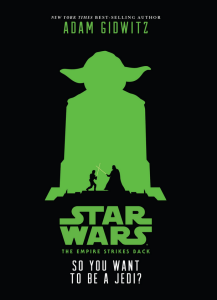

 So you want to be a Jedi? I get that. It seems cool. You can move things with your mind. Control people with your thoughts. Oh, and the lightsabers. Yeah, those are awesome. But listen, it’s not all mind control and weaponized flashlights. Being a Jedi requires patience and strength and self-awareness. And training. Lots of training. You still want to be a Jedi? Tell you what. I’m going to tell you a story. Not just a story. The story. The story of one of the greatest Jedi ever. As I tell it, I’m going to give you some tests. To see if you’ve got what it takes. If you’re afraid, I don’t blame you. Most folks don’t have what it takes. Most folks are just ordinary. Which is okay. There is nothing wrong with ordinary. But if you’re ordinary, you can’t be a Jedi. Do you want to hear the story? And do you want to undergo the tests? Do you still want to be a Jedi? Okay. This is the story of a young man. His name was Luke Skywalker. Now, even though this story is about him, I’m not going to tell it that way. You want to become a Jedi. He became one of the greatest Jedi of all. If you want to follow in his footsteps, you need to walk in his shoes. I mean, really walk in his shoes. And wear his clothes. And carry his lightsaber. And share his friends. And fight his enemies. You need, for the duration of this story, to become Luke. If you do, you will have walked the long, difficult, dangerous path of a Jedi. That path begins a long time ago in a galaxy far, far away. . . .
So you want to be a Jedi? I get that. It seems cool. You can move things with your mind. Control people with your thoughts. Oh, and the lightsabers. Yeah, those are awesome. But listen, it’s not all mind control and weaponized flashlights. Being a Jedi requires patience and strength and self-awareness. And training. Lots of training. You still want to be a Jedi? Tell you what. I’m going to tell you a story. Not just a story. The story. The story of one of the greatest Jedi ever. As I tell it, I’m going to give you some tests. To see if you’ve got what it takes. If you’re afraid, I don’t blame you. Most folks don’t have what it takes. Most folks are just ordinary. Which is okay. There is nothing wrong with ordinary. But if you’re ordinary, you can’t be a Jedi. Do you want to hear the story? And do you want to undergo the tests? Do you still want to be a Jedi? Okay. This is the story of a young man. His name was Luke Skywalker. Now, even though this story is about him, I’m not going to tell it that way. You want to become a Jedi. He became one of the greatest Jedi of all. If you want to follow in his footsteps, you need to walk in his shoes. I mean, really walk in his shoes. And wear his clothes. And carry his lightsaber. And share his friends. And fight his enemies. You need, for the duration of this story, to become Luke. If you do, you will have walked the long, difficult, dangerous path of a Jedi. That path begins a long time ago in a galaxy far, far away. . . .
Are you surprised that I’ve written this book?
I may seem a strange choice to retell The Empire Strikes Back. I am known, where I am known at all, for fairy tales. Particularly dark, scary fairy tales.
I started working on fairy tales in 2008. I was working as a substitute librarian at a school in Brooklyn, and I picked up a book of Grimm’s tales to read to a class of second graders. They were entertained, enthralled, enriched and, to be honest, slightly traumatized. Inspired by this experience, I wrote my first novel, A Tale Dark and Grimm, which tells the “true” story of Hansel and Gretel by retelling many of the scarier, weirder, lesser-known Grimm tales. My next two books, In a Glass Grimmly and The Grimm Conclusion, follow a similar model.
What do I know, then, about The Empire Strikes Back?
More than I thought, it turns out.
You may be aware that George Lucas always thought of Star Wars as a fairy tale. He said as much at a banquet honoring the great scholar of mythology Joseph Campbell: “I set out to write a children’s film. I had an idea of doing a modern fairy tale…” Later, in an interview with Bill Moyers for the PBS series The Power of Myth, Lucas said about Star Wars, “If it’s a tool that can be used to make old stories be new, and relate to younger people, that’s what the whole point was.”
Well, that’s what I was trying to do with Grimm’s fairy tales. To make the old stories new. To help younger people see the brilliance, the terror, the hilarity, and the beauty of those old tales. Lucas also said that he was “telling an old myth in a new way,” that he was “localizing it for the end of the millennium.” And now, I have the extreme privilege of taking what I wholeheartedly believe is the greatest modern fairy tale and retelling it in book form—and in so doing, localizing it for the young people of our new millennium.
People sometimes complain that Luke Skywalker is not much of a character. He does not brim with personality, as Han Solo and Princess Leia do. He is a little bland. A little empty.
Which is just as it should be. The hero of a fairy tale must be empty. What do we know of Cinderella, except that she has to work in the ashes and her family is mean to her? Do we know her sense of humor? Her taste in literature? Her opinions on the politics of her kingdom? Of course not. That would ruin the story. Because the point of Cinderella is that we can put ourselves in her shoes (which, according to the Brothers Grimm, were made of gold, not glass). We all feel like Cinderella sometimes—mistreated, unappreciated, with great potential that has yet to be recognized. Her story has endured for so long, and in so many different cultures, exactly for that reason. Because she is so universal. So universally empty.
Many modern heroes are created in that mold. Huckleberry Finn isn’t—you’d know him if you met him, even if he didn’t tell you his name. But Harry Potter is. He doesn’t have a sharply drawn personality, the way Ron and Hermione have. What do we know about Harry? That he’s brave? That he cares for his friends? Frodo Baggins is another example. We know Samwise well. Even Bilbo was an idiosyncratic little hero, bobbing from breakfast to elevenses with a grumpy, frumpy, good-willed reluctance. Frodo has some of that, but not much. Mostly, he’s brave and good.
These heroes are not full characters. They are empty. Intentionally so. They are avatars for the reader. They are empty so we can inhabit them, so we can do their deeds, live their lives, and learn their lessons. Luke is such a character. Empty as a pair of shoes.
In his The Power of Myth series, Bill Moyers said to George Lucas, “I hear so many young people today talk about a world that is emptied of heroism—that there are no more heroic things to do.” Lucas responded, “Everybody has a choice of being a hero or not being a hero, every day of their lives.”
I wrote this book to give you that choice. I’ve measured those shoes just for you.
Will you put them on?
Gidwitz turns to second-person narration in his retelling of The Empire Strikes Back. In an author’s note, this reteller of fairy tales explains that a certain type of protagonist—Luke, for instance—has a fairly empty characterization, enabling readers to “inhabit” the hero. This sets up the novel’s proper introduction, in which the narrator directly addresses readers who wish to become Jedis, explaining that simply telling Luke’s story isn’t enough and that they “need, for the duration of this story, to become Luke.” Substituting “you” for Luke, Gidwitz proceeds with his story. After fleeing a discovered rebel base, Luke follows a vision of Obi-Wan Kenobi to the swamp planet Dagobah, where the Jedi Master Yoda lives. There, Gidwitz takes advantage of the novel’s format to allow readers to share Luke’s frustration with Yoda’s emphasis on patience. Meanwhile, in conventionally narrated chapters, Leia, Han, and the gang engage in daring exploits to evade Darth Vader only to be betrayed by Han’s old friend, Lando. Vader uses them to set a trap for Luke, who, still so early in his training, is not ready to face the full force of the dark side, resulting in a major blow to the heroes. In between chapters, the narrator instructs readers in various Jedi training meditation exercises; sometimes they detract from the story’s rhythm, but generally they’re decent fun.